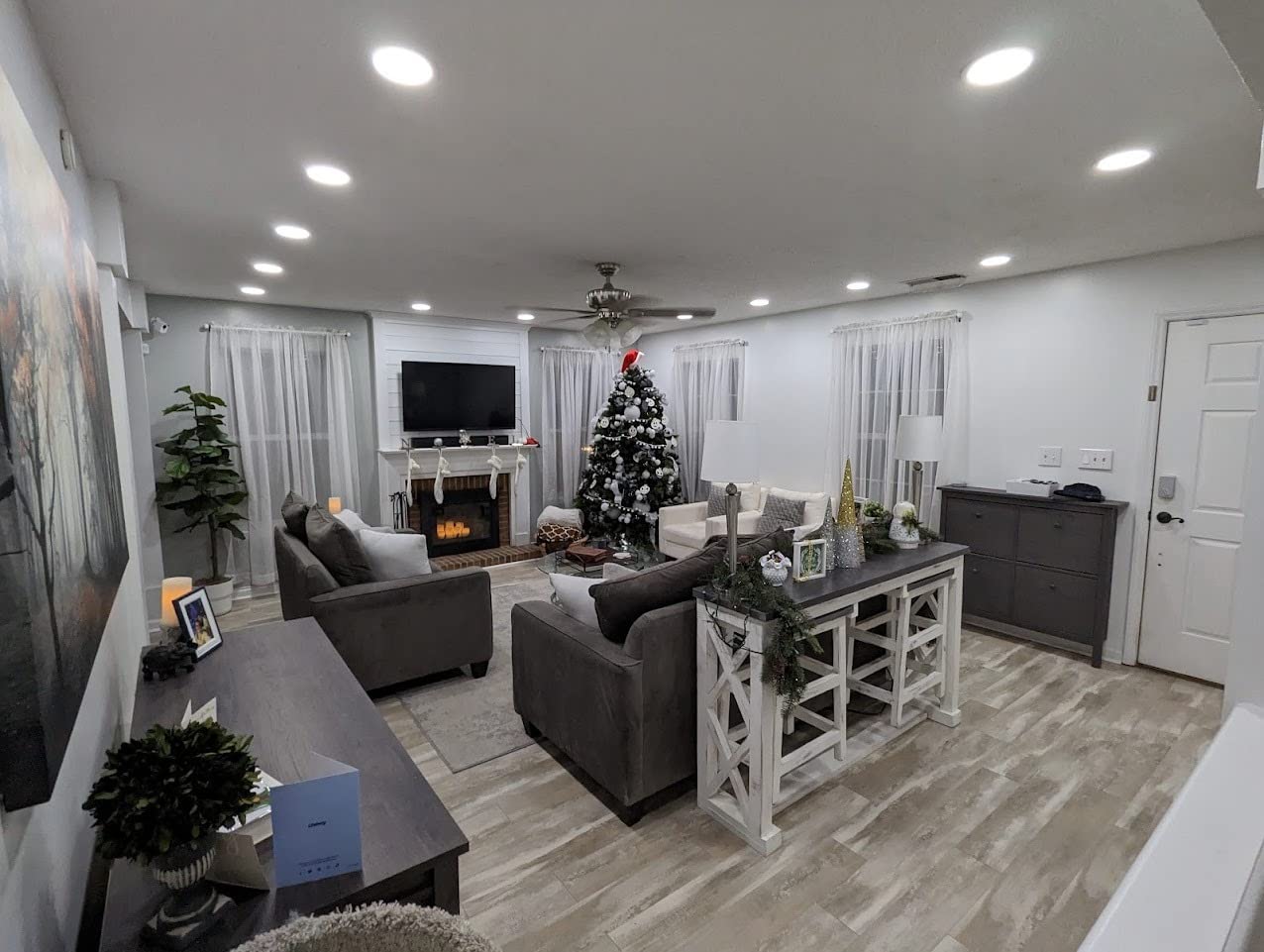Replacing a recessed LED can light is a relatively simple process that you can do yourself with a few basic tools. Here’s a step-by-step guide on how to safely replace your recessed LED can light:
Tools and Materials Needed:
- Replacement LED recessed light or retrofit kit (if applicable)
- Ladder (for high ceilings)
- Screwdriver (if screws are involved)
- Voltage tester (optional, for safety)
- Gloves (optional, for protection)
Step-by-Step Instructions:
1. Turn Off the Power
The most important step is to turn off the power to the light at the circuit breaker. You can also test with a voltage tester to make sure there is no electricity running to the light before starting.
2. Allow the Light to Cool
If the LED can light has been on recently, allow it to cool down for a few minutes. Although LEDs don’t get as hot as traditional incandescent bulbs, it’s still important to avoid burns.
3. Set Up a Ladder (If Needed)
If the light is located in a high ceiling area, use a sturdy ladder to reach the fixture safely. Make sure the ladder is stable and placed securely under the light.
4. Remove the Trim
The trim (the outer ring of the recessed light) is usually the part that is most visible. Depending on your fixture, the trim can be attached in one of two ways:
- Spring clips: Simply pull the trim down gently from the ceiling. The springs will release, and you can remove the trim.
- Screws: If the trim is held in place by screws, use a screwdriver to remove them before gently pulling the trim away.
5. Remove the Old LED Fixture or Bulb
There are two types of setups for recessed lighting:
- If it’s a replaceable LED bulb: Twist the LED bulb counterclockwise to remove it from the socket. After removing the bulb, set it aside for disposal or replacement.
- If it’s an integrated LED module: These fixtures don’t use separate bulbs. If your light is an integrated LED, you’ll need to replace the entire fixture. Look for screws or clips that secure the LED module to the housing and remove them to disconnect the module.
6. Disconnect the Wiring (If Necessary)
If you’re replacing the entire fixture (an integrated LED light), you’ll need to disconnect the wiring from the old fixture.
- Turn off the power at the breaker to ensure safety.
- Use a screwdriver to remove the screws from the wire connectors. Disconnect the wires, noting the color coding for reconnection (typically black for hot, white for neutral, and green or copper for ground).
7. Install the New LED Fixture
Once the old light is removed and the wires are disconnected, it’s time to install the new fixture. The process can vary slightly depending on whether you’re installing a retrofit kit or a new LED module.
- For a Retrofit Kit: Align the new LED module with the existing can (the housing in the ceiling) and follow the instructions provided with the kit to secure it in place. Retrofit kits are designed to fit into existing housings and are relatively easy to install.
- For a New LED Bulb: If you’re simply replacing the bulb, insert the new LED bulb into the socket and twist it clockwise to secure it in place.
8. Reconnect the Wiring (If Applicable)
If you disconnected the wiring earlier, now it’s time to reconnect it to the new fixture. Match the wires correctly:
- Black wire to black wire (hot).
- White wire to white wire (neutral).
- Green or copper wire to the ground.
Tighten the wire connectors and make sure all connections are secure.
9. Reattach the Trim
Once the new fixture is securely installed, it’s time to reattach the trim.
- For spring clips: Simply snap the trim back into place. The clips will hold it securely against the ceiling.
- For screws: Align the trim and use a screwdriver to screw it back into place.
10. Turn On the Power
Once everything is reassembled, go back to the circuit breaker and turn the power back on. Flip the light switch to check that your new recessed LED light is working properly. The light should turn on immediately without any flickering.
Troubleshooting Tips:
- The Light Won’t Turn On: Double-check that the power is on and that the bulb or fixture is securely installed. Also, check the connections to make sure the wires are tightly secured.
- Flickering LED Light: This can happen if the fixture is incompatible with your dimmer switch. Try replacing the dimmer switch with one designed for LED lights or use a non-dimmable switch.
- Light Doesn’t Fit: If the new fixture doesn’t fit properly into the can housing, make sure you’ve selected the correct size and type. Retrofit kits should fit most existing can light housings, but be sure to follow manufacturer instructions for correct sizing.
Frequently Asked Questions (FAQ)
1. Do I need an electrician to replace my recessed LED can light?
- It’s typically safe to replace a recessed LED light on your own if it’s a simple bulb replacement or retrofit kit. If you’re dealing with complex wiring, an integrated LED fixture, or issues with the circuit, it’s a good idea to hire an electrician.
2. What if the LED recessed light is dimmable, but the new one isn’t?
- If your new LED light isn’t dimmable but you want it to be, you’ll need to install a dimmable LED version. Also, make sure your dimmer switch is compatible with LEDs to avoid flickering.
3. Can I install a non-LED bulb in my recessed can light?
- You can technically install a non-LED bulb in your recessed can light if the fixture supports it, but it’s recommended to use LED bulbs for their energy efficiency, long lifespan, and lower heat production.
4. How can I prevent my recessed lights from buzzing or flickering?
- To prevent buzzing or flickering, ensure that your recessed lights are compatible with your dimmer switch. You can also try replacing the dimmer with one specifically designed for LED lighting.
Replacing a recessed LED can light is a straightforward task that requires basic tools and a little bit of care. Whether you’re replacing an old bulb or upgrading to a new LED fixture, following these steps ensures the process goes smoothly and safely. If you’re unsure at any point or encounter wiring issues, it’s always best to consult with a professional electrician.



 NO 8 Building,Yanluo Street,
NO 8 Building,Yanluo Street,